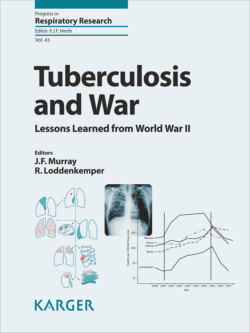Читать книгу Tuberculosis and War - Группа авторов - Страница 59
На сайте Литреса книга снята с продажи.
Pre-War Control Measures
ОглавлениеThe epidemiologic assessment of the TB situation is based mainly on mortality data. The notification of active TB cases for the assessment of TB morbidity was not yet commonly introduced.
TB control measures mainly aimed at preventing the transmission of the TB bacilli from infectious patients to their contacts. An important step for the isolation of infectious patients was to admit them to a TB sanatorium. Many TB sanatoria had been opened already in most countries. There, bed rest, provision of high-caloric food, and sunlight were the leading therapeutic approach; in selected cases treatment modalities such as artificial pneumothorax or more invasive surgical procedures were performed [46]. Compulsory isolation of “difficult” patients was allowed in Germany. Most countries had already introduced an ambulatory structure with dispensaries for special TB care, usually run under the responsibility of the local or national government.
The main diagnostic method was the microscopic examination of the expectorated sputum in suspicious cases. Radiography or fluoroscopy for diagnostic purposes had been introduced in the 1920s, but were not used for routine screening of the general population. X-ray screening was applied, however, in the military service of some countries. Tuberculin skin tests were usually not performed as a routine screening method, but sometimes for diagnosis of cases suspected of having TB.
The pasteurization of milk and the culling of infected (tuberculin-positive) cattle to prevent the transmission of bovine TB was not generally introduced. Only in few countries, BCG vaccination was established on a broad basis.
